博弈大赛赛前培训_六棋子程序的实现
桥牌博弈思维及训练

一、引言桥牌博弈不仅仅是一项竞技活动,更是一项需要高超思维能力的智力游戏。
在这篇文章中,我们将探讨桥牌博弈中的思维方式和训练方法,以提高玩家的竞技水平。
二、读牌能力读牌是桥牌博弈中的基本技能,它要求玩家通过观察对手的出牌情况,推断出他们手中的牌型组合和牌力。
通过训练读牌技巧,玩家可以更好地制定出适合自己的打牌策略。
三、决策判断在桥牌博弈中,正确的决策判断是至关重要的。
玩家需要根据自己的牌型、牌力以及对手的出牌情况,快速做出最优的决策。
通过模拟实战和总结经验教训,可以提高决策判断的准确性和速度。
四、牌力评估牌力评估是桥牌博弈中的核心技能之一。
玩家需要对自己的牌型组合和牌力进行准确的评估,以便在叫牌和打牌过程中做出正确的决策。
通过大量的实战和对局分析,可以提高玩家的牌力评估能力。
五、竞叫策略竞叫是桥牌博弈中的重要环节,它要求玩家在叫牌过程中传递出自己手中的信息,并干扰对手的判断。
通过学习各种叫牌体系和策略,以及进行实战模拟训练,可以提高玩家的竞叫能力。
六、防守技巧防守是桥牌博弈中的重要技巧之一,它要求玩家在打牌过程中采取正确的防守策略和技巧,以干扰对手的进攻。
通过学习各种防守技巧和方法,以及进行实战模拟训练,可以提高玩家的防守能力。
七、攻防配合攻防配合是桥牌博弈中的高级技巧之一,它要求玩家在打牌过程中能够根据实际情况采取合适的攻防策略,以最大限度地发挥自己的优势。
通过学习各种攻防配合的技巧和方法,以及进行实战模拟训练,可以提高玩家的攻防配合能力。
八、心理战术心理战术是桥牌博弈中的重要组成部分,它要求玩家能够通过观察和分析对手的行为和情绪变化,采取合适的心理策略来干扰对手的判断和发挥。
通过学习各种心理战术和技巧,以及进行实战模拟训练,可以提高玩家的心理战术运用能力。
提高桥牌博弈水平需要长期的学习和实践。
玩家应该不断学习新的知识和技能,并经常进行复盘和总结,以便更好地发现自己的不足和改进空间。
通过不断地学习和实践,玩家的思维能力和竞技水平将会得到不断提升。
软件工程课设六子棋

编号:软件工程课程设计说明书题目:六子棋游戏软件开发学院:计算机科学与工程学院专业:信息安全学生姓名:马文亭学号:1200360204指导教师:谢武2015年10月8日六子棋是流传于中国民间的一类版图游戏。
是一种双人对弈搏杀的一种游戏,交战双方棋子数均为六颗,故称六子棋。
六子棋不同于五子棋,没有过多的棋子无论是从感观上还是公平性上都要优先于五子棋,六子棋的规则简单易懂,不像国际棋规则中的繁复规则,适用于各个年龄段的人玩。
规则简单明了,游戏对环境的要求不高,孩子们大都是在光滑的地面或石板上画上方格,以石子或木棍、草节等为棋子,并有简单的比赛,可以锻炼脑力。
随着经济的发展和人们的生活水平的提高,每个人的业余休闲时间越发增多。
人们也已经开始厌烦这灯红酒绿的生活,所以有许多的青年人多一起老一辈们所玩的游戏越发的感兴趣,其中六子棋就是再度兴起的一种小型的游戏,各种网站关于六子棋的网页版游戏频繁出现,令人耳目一新啊,例如3366小游戏,手机版的六子棋游戏也开始渐渐走入各种类型的手机中,为人民增添了生活的乐趣丰富了大家的娱乐时间。
让很多人重温70、80后玩家儿时的感动,让小孩子感受到父母儿时的乐趣。
根据社会上人们对游戏的热切程度,把以前的游戏通过科学技术转换成现代的小游戏软件。
设计该软件采用了JAVA技术并且借鉴了很多小的游戏网站的六子棋游戏,制作了一个简单方便的游戏。
具体实现了这个游戏更加方便了喜欢六子棋的人群,不需要反反复复的花棋盘找棋子。
不仅仅丰富了人们的生活,增加了娱乐项目,有为人民带去便利,让大众的生活充满欢乐。
第1章绪论 (1)1.1 课题背景和意义 (1)1.1.1课题背景 (1)1.1.2意义 (1)1.2 国内发展现状 (2)1.3 论文的主要工作 (2)1.4 论文章节的安排 (2)第2章可行性分析和需求分析 (3)2.1 可行性分析 (3)2.1.1技术可行性分析 (3)2.1.2 经济可行性 (3)2.1.3 政策的可行性 (4)2.2 用户分类及功能说明 (4)第3章系统实现 (5)3.1 模块实现 (5)3.1.1主界面 (5)3.1.2 游戏界面 (10)3.2 打包与安装 (18)第4章测试 (19)4.1 软件测试 (19)4.1.1测试用例 (19)4.1.2测试结果 (20)4.2 结果分析 (26)第5章结束语 (28)5.1 总结 (28)5.1.1已完成系统的功能 (28)5.1.2 系统使用价值 (28)5.2 展望 (28)5.2.1 未完成系统的功能 (28)5.2.2 未来的工作 (29)参考文献 (30)第1章绪论1.1 课题背景和意义1.1.1课题背景六子棋是流传于中国民间的一类版图游戏。
大学生棋子牌大赛简洁活动策划书
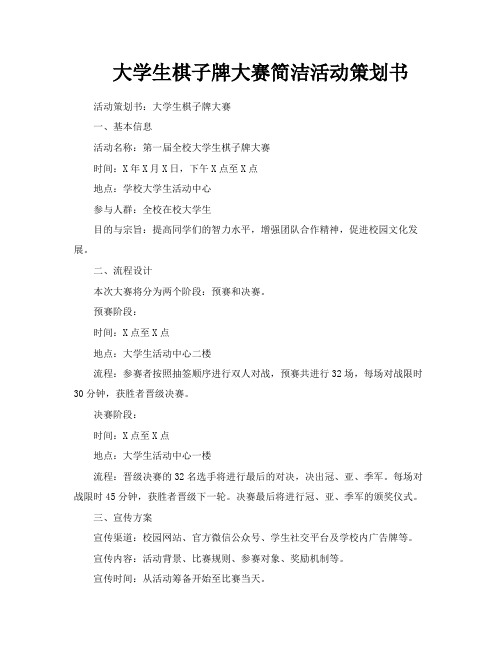
大学生棋子牌大赛简洁活动策划书活动策划书:大学生棋子牌大赛一、基本信息活动名称:第一届全校大学生棋子牌大赛时间:X年X月X日,下午X点至X点地点:学校大学生活动中心参与人群:全校在校大学生目的与宗旨:提高同学们的智力水平,增强团队合作精神,促进校园文化发展。
二、流程设计本次大赛将分为两个阶段:预赛和决赛。
预赛阶段:时间:X点至X点地点:大学生活动中心二楼流程:参赛者按照抽签顺序进行双人对战,预赛共进行32场,每场对战限时30分钟,获胜者晋级决赛。
决赛阶段:时间:X点至X点地点:大学生活动中心一楼流程:晋级决赛的32名选手将进行最后的对决,决出冠、亚、季军。
每场对战限时45分钟,获胜者晋级下一轮。
决赛最后将进行冠、亚、季军的颁奖仪式。
三、宣传方案宣传渠道:校园网站、官方微信公众号、学生社交平台及学校内广告牌等。
宣传内容:活动背景、比赛规则、参赛对象、奖励机制等。
宣传时间:从活动筹备开始至比赛当天。
四、预算和资源需求1.人员:裁判16人,志愿者20人。
2.物资:棋子牌100套,桌子10张,椅子20把,奖杯3个,证书30张。
3.场地:大学生活动中心一楼、二楼。
4.餐饮:为参赛者和工作人员提供简单的饮料和小吃。
5.交通:确保场地间的顺畅交通,提供必要的交通支持。
预算来源:活动经费拨款,企业赞助。
五、安全与风险控制1.安全措施:确保比赛期间选手和观众的人身安全,如遇突发情况,启动应急预案。
2.风险控制:预先评估可能出现的问题,如设备故障、选手冲突等,制定相应的应对措施。
明确比赛规则,确保比赛公平公正。
同时,加强对比赛现场的监控,防止出现意外情况。
在赛前对所有参赛者进行安全教育,提醒他们注意比赛礼仪和遵守比赛规则。
对于在比赛过程中出现的任何违规行为或冲突,我们将进行及时的干预和调解,以确保比赛的顺利进行和安全性。
此外,我们还将做好现场的消防安全工作,确保在突发情况下能够迅速采取应对措施,保障所有参赛者和观众的安全。
基于MTD(f)算法的六子棋程序设计研究
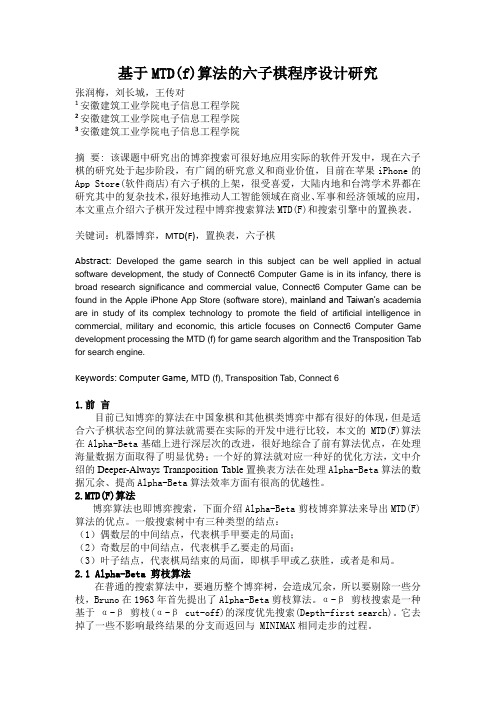
基于MTD(f)算法的六子棋程序设计研究张润梅,刘长城,王传对1安徽建筑工业学院电子信息工程学院2安徽建筑工业学院电子信息工程学院3安徽建筑工业学院电子信息工程学院摘要: 该课题中研究出的博弈搜索可很好地应用实际的软件开发中,现在六子棋的研究处于起步阶段,有广阔的研究意义和商业价值,目前在苹果iPhone的App Store(软件商店)有六子棋的上架,很受喜爱,大陆内地和台湾学术界都在研究其中的复杂技术,很好地推动人工智能领域在商业、军事和经济领域的应用,本文重点介绍六子棋开发过程中博弈搜索算法MTD(F)和搜索引擎中的置换表。
关键词:机器博弈,MTD(F),置换表,六子棋Abstract:Developed the game search in this subject can be well applied in actual software development, the study of Connect6 Computer Game is in its infancy, there is broad research significance and commercial value, Connect6 Computer Game can be found in the Apple iPhone App Store (software store), mainland and T aiwan’s academia are in study of its complex technology to promote the field of artificial intelligence in commercial, military and economic, this article focuses on Connect6 Computer Game development processing the MTD (f) for game search algorithm and the Transposition T ab for search engine.Keywords:Computer Game, MTD (f), Transposition Tab, Connect 61.前言目前已知博弈的算法在中国象棋和其他棋类博弈中都有很好的体现,但是适合六子棋状态空间的算法就需要在实际的开发中进行比较,本文的MTD(F)算法在Alpha-Beta基础上进行深层次的改进,很好地综合了前有算法优点,在处理海量数据方面取得了明显优势;一个好的算法就对应一种好的优化方法,文中介绍的Deeper-Always Transposition Table置换表方法在处理Alpha-Beta算法的数据冗余、提高Alpha-Beta算法效率方面有很高的优越性。
六子棋人工智能系统的设计与研究

六子棋人工智能系统的设计与研究六子棋是一种智力游戏,这需要玩家们思考和计算出最佳的走法。
人工智能技术已经开始在棋类游戏中得到广泛应用,因为这种技术可以更快、更准确地找出最佳解决方案。
在这篇论文中,我们将探讨一个六子棋人工智能系统的设计与研究。
设计人工智能系统的设计应该包括模型训练、模型部署和应用开发。
在六子棋的情况下,我们可以采用深度学习的技术来实现人工智能。
具体步骤如下:1. 数据收集。
我们需要从现有的六子棋游戏中获取大量的棋局数据,并标注每一步的胜负情况。
2. 数据清洗。
为了让模型学习更加准确,我们需要对数据进行清洗,删除重复或无效的数据,并保留有效的数据。
3. 模型选择。
在深度学习中,我们可以采用神经网络,将六子棋游戏界面当成输入,以胜负情况作为输出,通过训练模型来实现人工智能。
4. 模型训练。
我们需要将数据分成训练集和测试集,并使用训练集来训练神经网络模型。
通过多次迭代训练,使模型逐渐学会预测胜负情况。
5. 模型部署。
训练好的模型需要部署到实际的应用中,可以采用Web或移动端等部署方式,提供给用户实时对战或人机对战。
应用通过上述设计的应用开发,我们可以实现多种六子棋应用,如:1. 人机对战。
玩家可以与人工智能进行六子棋对战,挑战人工智能的高级算法。
2. 多人对战。
玩家可以通过网络与其他玩家进行六子棋比赛,体验不同玩家的棋艺和策略。
3. 战局分析。
系统可以将每一场六子棋比赛的棋局都保存下来,并进行数据分析,帮助玩家掌握更多棋局胜利策略。
4. 棋谱库。
系统可以建立一个六子棋棋谱库,保存六子棋比赛的最佳棋谱,帮助玩家学习借鉴。
5. 六子棋教学。
系统可以提供六子棋的相关教学视频和素材,帮助玩家更深入地学习六子棋的规则和策略。
结论在本文中,我们提出了一个六子棋人工智能系统的设计和研究方法,可以实现人机对战和多人对战,战局分析和棋谱库,六子棋教学等应用,帮助玩家更好地掌握六子棋技巧和战术。
这个六子棋人工智能系统有望成为六子棋爱好者的理想平台,提高他们的兴趣和技艺水平。
六子棋博弈系统设计与实现
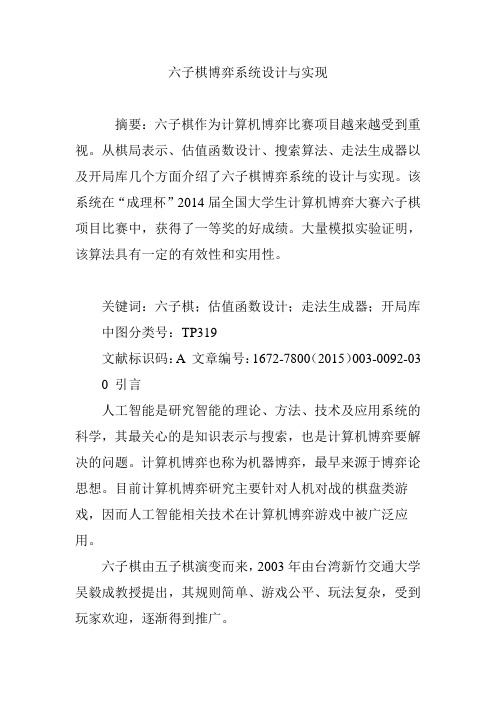
六子棋博弈系统设计与实现摘要:六子棋作为计算机博弈比赛项目越来越受到重视。
从棋局表示、估值函数设计、搜索算法、走法生成器以及开局库几个方面介绍了六子棋博弈系统的设计与实现。
该系统在“成理杯”2014届全国大学生计算机博弈大赛六子棋项目比赛中,获得了一等奖的好成绩。
大量模拟实验证明,该算法具有一定的有效性和实用性。
关键词:六子棋;估值函数设计;走法生成器;开局库中图分类号:TP319文献标识码:A 文章编号:1672-7800(2015)003-0092-030 引言人工智能是研究智能的理论、方法、技术及应用系统的科学,其最关心的是知识表示与搜索,也是计算机博弈要解决的问题。
计算机博弈也称为机器博弈,最早来源于博弈论思想。
目前计算机博弈研究主要针对人机对战的棋盘类游戏,因而人工智能相关技术在计算机博弈游戏中被广泛应用。
六子棋由五子棋演变而来,2003年由台湾新竹交通大学吴毅成教授提出,其规则简单、游戏公平、玩法复杂,受到玩家欢迎,逐渐得到推广。
六子棋标准棋盘为19×19,黑白双方轮流下棋,除了第一次由黑方先下一颗子外,其后各方每轮下两颗棋子,连成六子(或以上)者获胜,如图1所示。
六子棋没有禁手,长连(连成六子以上)即算赢棋,若全部棋盘填满仍未分出胜负则算和棋。
图1 六子棋棋盘本文主要从棋盘表示、走法生成器、估值函数设计、搜索算法实现以及开局库几个方面介绍六子棋博弈系统的设计与实现。
1 棋盘表示棋盘的表示一般有数组表示法和比特表示法,比特表示法又称为位棋盘。
六子棋棋盘一般为19×19,若用二维数组表示棋盘即为Board[19][19]。
采用位棋盘的作用就是记录棋盘上的某些布尔条件,根据布尔值放入对应的棋子。
位棋盘如今广泛应用在六子棋中,原因是效率高、占用空间小。
本文程序采用64位长度的变量,与数组表示法相比较,位棋盘每19个点需要38位。
用64位长度的变量表示,19行就需19×8B,即为152B,而数组表示法需要361B。
国际象棋博弈比赛规则知识宣传通用PPT模板
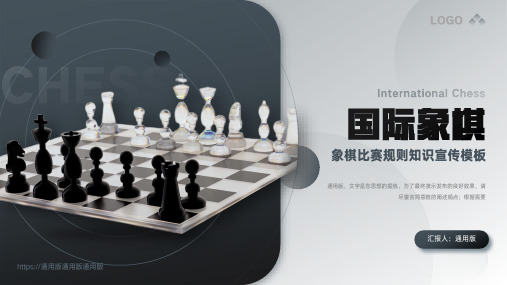
https://通用版通用版通用版
INTERNATIONAL CHESS
认识国际象棋
Understanding chess
通用版,文字是您思想的提炼,为了最终演示发布的良好效果,请 尽量言简意赅的阐述观点;根据需要
认识国际象棋
认识国际象棋
通用版,文字是您思想的提炼,为了最终演示发 布的良好效果,请尽量言简意赅的阐述观点;根 据需要可酌情增减文字,以便观者可以准确理解 您所传达的信息。通用版,文字是您思想的提炼, 为了最终演示发布的良好效果,请尽量言简意赅 的阐述观点;根据需要可酌情增减文字,以便观 者可以准确理解您所传达的信息。
通用版,文字是
通用版,文字是
通用版,文字是
通用版,文字是
通用版,文字是
著名棋手介绍好效果,请尽量言简意赅的阐述观点;根据需要可 酌情增减文字
• 通用版,文字是您思想的提炼,为了最终演示发布 的良好效果,
• 请尽量言简意赅的阐述观点;根据需要可酌情增减 文字,以便观者可以准确理解您所
通用版,文字是您思想的提炼,为了最终演示发布 的良好效果,请尽量言
通用版,文字是您思想的提炼,为了最终演示发布 的良好效果,请尽量言
通用版,文字是您思想的提炼,为了最终演示发布 的良好效果,请尽量言
比赛规则说明
通用版,文字是您思想的提炼,为了最终演示发布 的良好效果,请尽量言 通用版,文字是您思想的提炼,为了最终演示发布 的良好效果,请尽量言 通用版,文字是您思想的提炼,为了最终演示发布 的良好效果,请尽量言
比赛规则说明
比赛规则说明
通用版,文字是您思想的提炼,为了最终演示发 布的良好效果,请尽量言简意赅的阐述观点;根 据需要可酌情增减文字,以便观者可以准确理解 您所传达的信息。通用版,文字是您思想的提炼,
计算机博弈之六子棋的主要技术分析
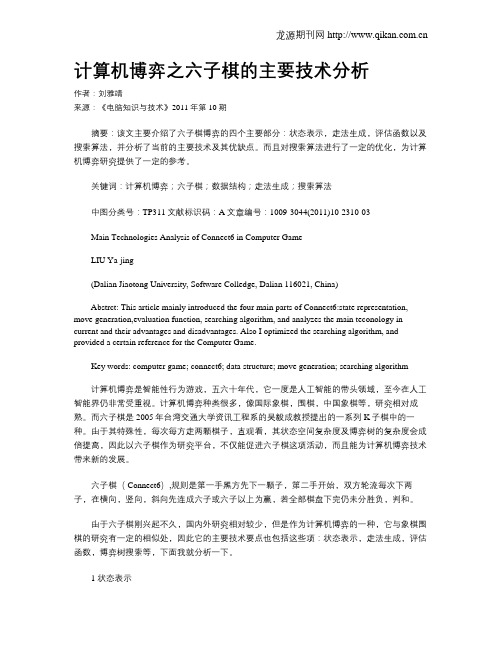
计算机博弈之六子棋的主要技术分析作者:刘雅靖来源:《电脑知识与技术》2011年第10期摘要:该文主要介绍了六子棋博弈的四个主要部分:状态表示,走法生成,评估函数以及搜索算法,并分析了当前的主要技术及其优缺点。
而且对搜索算法进行了一定的优化,为计算机博弈研究提供了一定的参考。
关键词:计算机博弈;六子棋;数据结构;走法生成;搜索算法中图分类号:TP311文献标识码:A文章编号:1009-3044(2011)10-2310-03Main Technologies Analysis of Connect6 in Computer GameLIU Ya-jing(Dalian Jiaotong University, Software Colledge, Dalian 116021, China)Abstrct: This article mainly introduced the four main parts of Connect6:state representation, move generation,evaluation function, searching algorithm, and analyzes the main teconology in current and their advantages and disadvantages. Also I optimized the searching algorithm, and provided a certain reference for the Computer Game.Key words: computer game; connect6; data structure; move generation; searching algorithm计算机博弈是智能性行为游戏,五六十年代,它一度是人工智能的带头领域,至今在人工智能界仍非常受重视。
六子棋机器博弈关键技术分析PPT课件

徐长明、徐心和、王翠 荣
2011. 06. 13
五子棋
入手
• 起源于中国 • 发展在日本(棋型棋) • Renju / Go-Moku • 棋盘 15×15
五子棋机器博弈研究现状
入手
• 两种常见的五子棋均已经被成功破解 • Go-moku(无禁手):于1994年解决 • Renju(禁手):于2001年解决,花费了9000小时=375 天。
复杂度: 计算复杂度为PSPACE-complete; 平均分枝因子约为300; 每盘棋平均30步。
入手
研究现状:涉及到k子棋(如五子棋和六子棋)复 杂度的文献均高估了它的复杂度。
零
万事开头难,从哪里入手?
参考文献
入手
1. 六子棋 发明人吴毅成教授网站: /web/index.php?option=com_content&t ask=view&id=15&Itemid=26.
标准的六子棋是connect(19, 19, 6, 2, 1),标准的五子 棋是connect(15, 15, 5, 1, 1) 。
复杂度
入手
二人博弈问题一般至少属于NP-hard类,而且,多 属于PSPACE-complete(如奥赛罗) 或EXPTIMEcomplete(如中国象棋、西洋跳棋、国际象棋和围 棋等)类问题。
• 破解五子棋的重要因素 • 借助了机器博弈 • 当时恰好发现新算法——TSS(Threat Space Search)+PNS(Proof Number Search)
• 新的五子棋其规则变得复杂,致使趣味性大减
六子棋简介
入手
• 棋盘 19×19 • 6子棋型为胜 • 复杂度显著提高
棋类对弈活动策划书3篇

棋类对弈活动策划书3篇篇一棋类对弈活动策划书一、活动主题“以棋会友,棋乐无穷”二、活动目的1. 提供一个交流棋艺的平台,增进棋友之间的友谊。
2. 丰富同学们的课余生活,提高同学们的思维能力。
3. 培养同学们的竞争意识和团队合作精神。
三、活动时间和地点时间:[具体日期]地点:[详细地址]四、参与人员全体学生五、活动内容1. 棋类比赛(1)比赛项目:中国象棋、围棋、国际象棋等。
(2)比赛规则:根据不同棋种的规则进行比赛。
(3)比赛方式:分组淘汰赛和循环赛相结合。
2. 棋艺讲座(1)邀请专业棋艺老师或棋类爱好者进行棋艺讲座,介绍棋类文化和技巧。
(2)讲座内容包括棋类历史、开局技巧、中局策略、残局解法等。
3. 互动环节(1)设置棋类谜题或挑战,让参与者在规定时间内解决。
(2)组织观众与选手进行对弈,增加互动和娱乐性。
4. 颁奖仪式(1)颁发比赛奖项,表彰优秀选手。
(2)设置特别奖项,如最佳棋手、最佳表现奖等。
六、活动流程1. 活动开场:主持人介绍活动目的、流程和参赛选手。
2. 棋类比赛:按照比赛项目和规则进行比赛。
3. 棋艺讲座:专业棋艺老师进行棋艺讲座。
4. 互动环节:组织观众与选手进行对弈,进行棋类谜题挑战。
5. 颁奖仪式:颁发比赛奖项和特别奖项。
七、活动宣传1. 在学校宣传栏张贴活动海报。
2. 向各班级发放活动通知。
3. 在学校网站和社交媒体上发布活动信息。
八、活动预算1. 奖品费用:[具体金额]用于购买比赛奖品和特别奖项奖品。
2. 宣传费用:[具体金额]用于制作海报和宣传资料。
3. 讲座费用:[具体金额]用于邀请专业棋艺老师的费用。
4. 其他费用:[具体金额]用于活动场地布置、棋具租赁等费用。
九、注意事项1. 参赛选手需提前报名,并在比赛当天按时到达比赛场地。
2. 比赛过程中,选手需遵守比赛规则,尊重对手。
3. 观众需保持安静,不得干扰比赛进行。
4. 工作人员需提前准备好比赛所需的棋具和奖品。
5. 活动结束后,工作人员需清理好活动场地。
六子棋培训讲义
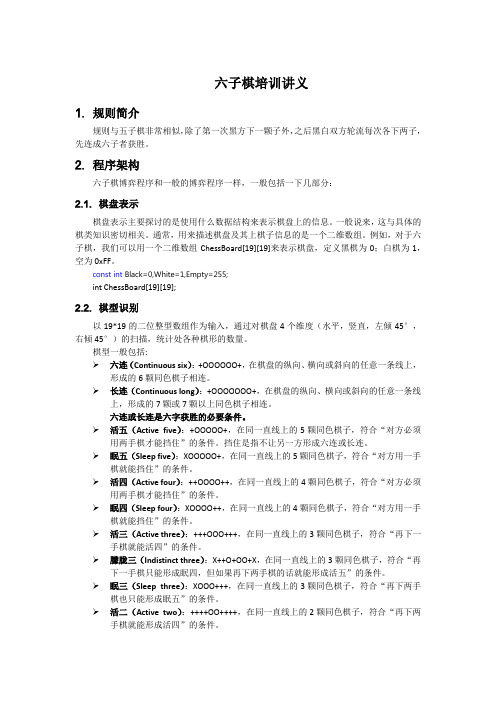
4. 5.
} 按照水平扫描棋型的方法分析该临时数组 标记扫描过的点
2.3. 评估系统
根据棋型识别所得的结果对当前棋局进行评估, 得到当前棋型的估值。 一般来讲估值越 大,局势对己方越有利。 2.3.1. 静态原始棋子位置得分 也就是位置得固有得分。其分值分布为:天元点分值最大,沿其四周分数依次递减,棋 盘四周分值最低。以 19*19 棋盘为例,我们可以建立静态棋子价值表。 int PosValue[19][19]= { {0,0,0,0,0,0,0,0,0,0,0,0,0,0,0,0,0,0,0}, {0,1,1,1,1,1,1,1,1,1,1,1,1,1,1,1,1,1,0}, {0,1,2,2,2,2,2,2,2,2,2,2,2,2,2,2,2,1,0}, {0,1,2,3,3,3,3,3,3,3,3,3,3,3,3,3,2,1,0}, {0,1,2,3,4,4,4,4,4,4,4,4,4,4,4,3,2,1,0}, {0,1,2,3,4,5,5,5,5,5,5,5,5,5,4,3,2,1,0}, {0,1,2,3,4,5,6,6,6,6,6,6,6,5,4,3,2,1,0}, {0,1,2,3,4,5,6,7,7,7,7,7,6,5,4,3,2,1,0}, {0,1,2,3,4,5,6,7,8,8,8,7,6,5,4,3,2,1,0}, {0,1,2,3,4,5,6,7,8,9,8,7,6,5,4,3,2,1,0}, {0,1,2,3,4,5,6,7,8,8,8,7,6,5,4,3,2,1,0}, {0,1,2,3,4,5,6,7,7,7,7,7,6,5,4,3,2,1,0}, {0,1,2,3,4,5,6,6,6,6,6,6,6,5,4,3,2,1,0}, {0,1,2,3,4,5,5,5,5,5,5,5,5,5,4,3,2,1,0}, {0,1,2,3,4,4,4,4,4,4,4,4,4,4,4,3,2,1,0}, {0,1,2,3,3,3,3,3,3,3,3,3,3,3,3,3,2,1,0}, {0,1,2,2,2,2,2,2,2,2,2,2,2,2,2,2,2,1,0}, {0,1,1,1,1,1,1,1,1,1,1,1,1,1,1,1,1,1,0}, {0,0,0,0,0,0,0,0,0,0,0,0,0,0,0,0,0,0,0}, }; 2.3.2. 对局势进行评估 在对棋局进行分析时,可以分为两种,第一种:棋盘得整体扫描。以 19 路棋盘为例, 需要计算 19+19=38 行阳线, (37-10)+(37-10)= 54 行阴线 ,共 92 路棋型得分。这里 92 路实际上可以划分为 4 个维度。即水平,竖直,左倾 45°,右倾 45°。第二种:以落子点 (或记录的 HP-3 棋型)为中心,向外延展 3 格检查(若研究对象是棋型,那么只需由向量 方向延展 3 格检查) 。 2.3.3. 潜力值的影响 有关潜力值得影响。 活二, 眠三, 如上面定义的, 看起来并不是很起眼。 他虽然不像 “四” 、 “五” ,那样具有非常直观的杀伤力,但是他往往是决定成败的关键因素。这里在一次提到 这个和 Connect(6,2,1)的特性是密不可分的。如果在活二的基础上沿其方向再连续增 添两子, 而其中一子又能与其它己方棋型形成一个威胁度的话, 那么就会马上获得胜利。 据 此我们可以设想构造一个形势评估函数(仅评估当前攻防趋势) ,如果一方没有活二,和一 些分布分散(可以用向量分析方法)的眠三,那么我们可以判断,此方目前进攻形式不佳, 只能加强防守,如果此时贸然冲四,可能导致顷刻告负。 相反,如果另一方,分布相对集 中的眠三,以及活二,那么我们可以考虑使用 VCF 战术。
六子棋PPT课件

目录 Contents
• 六子棋简介 • 六子棋基本战术 • 六子棋高级战术 • 六子棋实战技巧 • 六子棋常见错误 • 六子棋发展前景
01
六子棋简介
游戏起源
起源历史
六子棋,也称为连珠或五子棋,起源于中国,有着悠久的历史。据传,它在唐 代就已经出现,经过数千年的发展,逐渐成为一种深受人们喜爱的策略型棋类 游戏。
六子棋发展前景
六子棋的推广
01
02
03
制定推广策略
通过制定有效的推广策略 ,如组织比赛、宣传活动 等,提高六子棋的知名度 和影响力。
合作推广
与相关机构、企业合作, 共同推广六子棋,扩大其 受众范围。
社交媒体推广
利用社交媒体平台,发布 有关六子棋的资讯、赛事 信息和精彩瞬间,吸引更 多人关注和参与。
声东击西
总结词
通过分散对手的注意力,实现在其意想不到的地方取得优势。
详细描述
在六子棋中,有时需要故意在棋盘上制造一些假象,让对手误以为某处是关键点,从而分散其注意力。与此同时 ,在另一处布局自己的棋子,实现在对手疏忽的地方取得优势。
围魏救赵
总结词
通过围攻对手的某处棋子,迫使其放弃另一处的优势。
详细描述
02
六子棋基本战术
进攻战术
01
02
03
04
三连进攻
通过连续三次下子,在对方阵 地上形成三连,从而围困对方
棋子。
跳进攻
利用对方棋子的间隙,通过跳 跃的方式连接己方棋子,形成
连续进攻。
分散进攻
将己方棋子分散下在对方阵地 ,使对方难以形成有效的防线
。
夹击进攻
通过夹击对方棋子的方式,限 制其移动,为连续进攻创造机
智能六子棋博弈系统

智能六子棋博弈系统*
成果完成年份:2011年9月
成果简介:本项目是基于windows系统的智能六子棋博弈系统。
本项目由学生自主开发并且参加2011年全国大学生计算机博弈锦标赛获得冠军(一等奖)。
项目来源:自行开发
技术领域:人工智能领域
应用范围:人机对弈及智能推演
现状特点:国内领先
技术创新:pvs搜索+ vcf探测胜负
所在阶段:研发完成
市场状况及效益分析:该项目已经是国内六子棋计算机博弈系统研究的领先者,可用作一些六子棋竞赛队平时训练用。
图片展示:。
博弈大赛赛前培训六棋子程序的实现

长连和六连是规定时间内获胜的必要条件。
/
博弈大赛赛前培训六棋子程序的实现
六子棋的棋型
活五:在同一直线上的5颗同色棋子,符合“对方必须 用两手棋才能挡住”的条件。“挡住”是指不让 另一方形成六连或长连。
/
ChessmanType = BLACK;
continue;/
博弈大赛赛前培训六棋子程序的实现
示例代码
else // if (strcmp(Msg,“white”) == 0) {
ChessmanType = WHITE; continue; } } //确定棋型颜色结束
if (strcmp(Msg,"move") == 0) {
//接收对方的招法 scanf("%s",Msg);
/
博弈大赛赛前培训六棋子程序的实现
示例代码
if (Msg[2] == ‘\0’) //接收黑方的第一着 {
//move XX\n y0 = (int)(Msg[0]) - (int)('A'); x0 = (int)('S') - (int)(Msg[1]); position[x0][y0] = !ChessmanType; }
//获得着法的坐标 x0 = m_cmBestMove.StonePos[0].x; y0 = m_cmBestMove.StonePos[0].y; x1 = m_cmBestMove.StonePos[1].x; y1 = m_cmBestMove.StonePos[1].y;
//将着法记录在棋盘中 position[x0][y0] = ChessmanType; position[x1][y1] = ChessmanType;
六子棋智能博弈系统的研究与实现

六子棋智能博弈系统的研究与实现作者:黄继平,张栋,苗华来源:《电脑知识与技术》2009年第25期摘要:六子棋作为一个新兴的游戏,已在棋类计算机智能博弈领域占有重要的位置,其为保证竞赛公平性而采取的一步两子的规则对计算机博弈的效率是很大的考验。
为此,在实现六子棋博弈系统状态表示、搜索策略和评估函数几大核心框架的基础上,提出“路”的概念,简化评估函数类型,有效提高博弈性能。
关键词:人工智能;博弈树;六子棋;中图分类号:TP181文献标识码:A文章编号:1009-3044(2009)25-7198-03The Research and Implementation of Connect6 Intelligent Chess Game SystemHUANG Ji-Ping, ZHANG Dong, MIAO Hua(School of Computer Science and Engineering, Chongqing University of Technology, Chongqing 4000504, China)Abstract: As a new game, Connect6 has held an important position in the field of Computer chess game intelligence. It's a big problem to the efficiency of Computer Game, because Connect6 puts two chessman in one step to ensure that the game is fair. So, based on the implementation of main components of Connect6 game: description of state, search engine and evaluation function, this paper makes a new conception: "road", which simplifies the evaluation functions and effectively improve game performance.Key words: artificial intelligence; game tree; connect6; genetic algorithms在人工智能领域始终将棋类的机器博弈作为常用的研究平台之一[1]。
六子棋PPT课件

在防守中,要避免被对手切断自己的路线,保持自己的势力范围。
等待对手失误
在防守中,要耐心等待对手的失误,利用对手的失误来转守为攻。
战略技巧
制定合理的战略
在棋局中,要根据自己的实际情 况和对手的情况,制定合理的战
略。
控制全局
在棋局中,要控制全局,使对手 无法有机地组织起有效的攻势。
转换攻防
在棋局中,要根据实际情况,灵 活转换攻防,使自己始终保持主
当任意一方在棋盘上形成6子连 线时,该方即获胜。
六子棋的魅力
智力竞技
六子棋是一种高智商的游 戏,需要玩家精心策划和 巧妙布局。
对抗性
六子棋具有强烈的对抗性 ,需要双方不断进行思考 和决策。
文化内涵
六子棋蕴含着丰富的文化 内涵,如阴阳五行、易经 八卦等。
CHAPTER 02
六子棋技巧
攻击技巧
抢占重要点位
增进友谊
促进交流与沟通
六子棋是一种两人游戏,需要双方进行交流和沟通,这有助于增 进友谊。
增进彼此了解
通过下棋,可以了解对方的思路、性格和习惯,有助于增进彼此的 了解。
培养竞技精神
在棋局中,需要遵守规则和礼仪,这有助于培养竞技精神,增进友 谊。
CHAPTER 06
六子棋的发展趋势和展望
推广价值
01
动地位。
CHAPTER 03
六子棋战术
总结词
在棋局开始时,抢占棋盘中心是六子棋中的重要战 术之一。
详细描述
在六子棋中,棋盘中心是控制全局的关键位置。抢占中心可以有 效地控制局面,限制对手的行动,并使自己的布局更加灵活和主 动。
总结词
通过控制局面,可以更好地判断形势,制定下一步的策略。
- 1、下载文档前请自行甄别文档内容的完整性,平台不提供额外的编辑、内容补充、找答案等附加服务。
- 2、"仅部分预览"的文档,不可在线预览部分如存在完整性等问题,可反馈申请退款(可完整预览的文档不适用该条件!)。
- 3、如文档侵犯您的权益,请联系客服反馈,我们会尽快为您处理(人工客服工作时间:9:00-18:30)。
计算机博弈与人工智能
博弈程序整体设计思路
实际问题
数学建模
算法
编程、调试
得到结果
计算机博弈与人工智能
棋盘表示
六子棋棋盘由19条横线和19条纵线组成。 棋盘一共有19*19=361个交点。
交点出现的可能情况:无子、黑子、白子
棋盘:char position[19][19]; 棋子: 黑棋(BLACK):0
接受裁判系统信息:scanf("%s",Msg);
传回裁判系统信息:printf("%s",Move);
1.确定队名:"name?“ 传回队名: "name BitStronger\n“
2.开局:"new" 3.确定黑白方:
黑方:"black" 白方:"white" 4.发送、接收招法 //先横向坐标,后纵向坐标 黑方第一步:move X0Y0
//记录棋子颜色
char Msg[500];
//保存接收到的消息
char name[] = “name 中国深度\n"; //队伍信息
char Move[] = "move AABB\n";
//走法
int x0,x1,y0, position, NOSTONE, GRID_COUNT);
if (strcmp(Msg,“black”) == 0) //确定我方棋子的颜色
{
Sleep(50);
//延迟一段时间发送,经测试,立即发 送可
//能造成平台无响应
printf("move JJ\n");
position[9][9] = BLACK;
fflush(stdout);
ChessmanType = BLACK;
白棋(WHITE):1 无子(NOSTONE):0xff
计算机博弈与人工智能
示例代码
宏定义:
#define GRID_NUM 19 //棋盘行数
#define GRID_COUNT 361 //可放棋子总数
#define BLACK 0
//黑棋
#define WHITE 1
//白棋
#define NOSTONE 0xff
计算机博弈与人工智能
示例代码
else //接收对方的招法,一般招法都是一着下两个子 {
//move XYXY\n y0 = (int)(Msg[0]) - (int)('A'); x0 = (int)('S') - (int)(Msg[1]); y1 = (int)(Msg[2]) - (int)('A'); x1 = (int)('S') - (int)(Msg[3]);
BYTE x; BYTE y; }STONEPOS;
//走法
typedef struct _stonemove
{
STONEPOS StonePos[2];
int
Score;
}STONEMOVE;
//棋子位置 //走法的分数
计算机博弈与人工智能
示例代码
主函数,程序的入口
void main()
{
int ChessmanType;
position[x0][y0] = !ChessmanType; position[x1][y1] = !ChessmanType; }
计算机博弈与人工智能
示例代码
if (SearchAGoodMove(position,ChessmanType)) {
//获得着法的坐标 x0 = m_cmBestMove.StonePos[0].x; y0 = m_cmBestMove.StonePos[0].y; x1 = m_cmBestMove.StonePos[1].x; y1 = m_cmBestMove.StonePos[1].y;
//无棋
全局变量:
BYTE position [GRID_NUM][GRID_NUM]; //棋盘
STONEMOVE m_cmBestMove; //记录着法
注: #include "windows.h"
typedef unsigned char BYTE
计算机博弈与人工智能
示例代码
结构定义: //棋子位置 typedef struct _stoneposition {
计算机博弈与人工智能
示例代码
if (Msg[2] == ‘\0’) //接收黑方的第一着 {
//move XX\n y0 = (int)(Msg[0]) - (int)('A'); x0 = (int)('S') - (int)(Msg[1]); position[x0][y0] = !ChessmanType; }
计算机博弈与人工智能
示例代码
while (1) {
//循环接收裁判平台发送的消息,注意需要发送的字符串应该 //以'\n'结束,裁判平台才会认为是一次完整的输入. //发送完需要调用fflush(stdout)清空输出缓冲区,使字符串 //立刻输出到裁判平台 memset(Msg,0,500); scanf("%s",Msg); if (strcmp(Msg,"name?") == 0) {
printf("%s",name); fflush(stdout); continue; }
计算机博弈与人工智能
示例代码
if (strcmp(Msg,“new”) == 0) //新开局
{
memset(position,NOSTONE,GRID_COUNT); //初始化 棋盘
scanf("%s",Msg);
continue;
计算机博弈与人工智能
示例代码
else // if (strcmp(Msg,“white”) == 0) {
ChessmanType = WHITE; continue; } } //确定棋型颜色结束
if (strcmp(Msg,"move") == 0) {
//接收对方的招法 scanf("%s",Msg);
//将着法记录在棋盘中 position[x0][y0] = ChessmanType; position[x1][y1] = ChessmanType;
LOGO
六子棋博弈程序
计算机博弈与人工智能协会
计算机博弈与人工智能
讲解要点
机器博弈交互平台 本次大赛通信协议 博弈程序整体设计思路 博弈程序核心模块
本次大赛的一些相关说明
计算机博弈与人工智能
机器博弈交互平台
棋盘
6 2
3
15
裁判系统
5
黑方程序
1
3 1
4
白方程序
计算机博弈与人工智能
本次大赛通信协议
